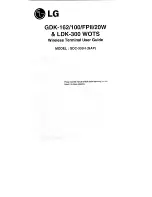
Peripheral Installation
Station Message Detail Recording (SMDR)
Strata CTX I&M 10/02
9-27
Pe
riphe
ra
l In
stall
ation
Station Message Detail Recording (SMDR)
For each incoming, outgoing, tandem or conference call, the Strata CTX can generate a record that
includes details of the call, including the originating station or trunk, the start time of the call, its
duration, authorization codes, etc. If a station user dials “911,” the Strata CTX also generates a
record at the beginning of the call as part of its internal notification that an emergency call is in
progress.
The BSIS optional PCB attaches to the ACTU of the CTX100 or the BECU of the CTX670 to
provide four RS-232 interface jacks (one for SMDR and one for SMDI). See
Figures 9-6
and
9-7
,
starting on
page 9-6
for connection information.
SMDR Record Types
Distinct records are generated for different types of calls. The table below lists the record types.
The type of each record is identified by a letter entry in the column of the record.
Table 9-1
Call Record Types
The use of multiple records allows the CTX to account for multi-stage calls such as transfers and
conferences. A simple outgoing or incoming call would generate a Normal record. A transferred
call would generate a Start record for the first segment of the call and an End record for the second
segment of the call. The appropriate times would be stored in each. A detailed description of
SMDR is provided in a separate manual.
Several fields in the record may displayed or masked based on system programming. They include
DISA security codes, authorization codes, ANI, DNIS and Caller ID.
The Strata CTX can buffer up to 1000 SMDR records in response to a loss of DTR signal from an
attached call accounting device or external buffer. When the buffer overflows, subsequent call
records will be lost until the buffer is cleared. The CTX buffer will be cleared by a system restart
or loss of system power.
Record Type
Notes
B (aBandoned)
When a call is abandoned
N (Normal)
Simple outgoing or incoming call
S (Start)
Start of complex outgoing or incoming call or 911 call
X (transfer)
When a call is transferred
E (End)
This record is associated with a specific S or X records, and indicates
termination of a call
I (Initial)
When system is initialized
T (Time)
When the system time or date is changed
A (Authorization)
When the input Account Code is verified and the result is successful, the
Account Code is defined as the Authorization Code.
C (Charge Account)
When an Account Code is entered
M (Charge Conference)
When an Account Code is entered during a conference call
Summary of Contents for Strata CTX100
Page 16: ...Introduction Related Documents Media xii Strata CTX I M 10 02 ...
Page 94: ...Strata CTX100 Installation Installing the CTX100 Cabinet 2 24 Strata CTX I M 10 02 ...
Page 150: ...Strata CTX670 Installation Remote Expansion Cabinet Unit 3 56 Strata CTX I M 10 02 ...
Page 188: ...PCB Installation Network Requirements 4 38 Strata CTX I M 10 02 ...
Page 238: ...T1 Loop Back Testing 6 12 Strata CTX I M 10 02 ...
Page 310: ...Station Apparatus 2000 series Telephones 8 48 Strata CTX I M 10 02 ...
Page 342: ...Peripheral Installation Station Message Detail Recording SMDR 9 32 Strata CTX I M 10 02 ...












































